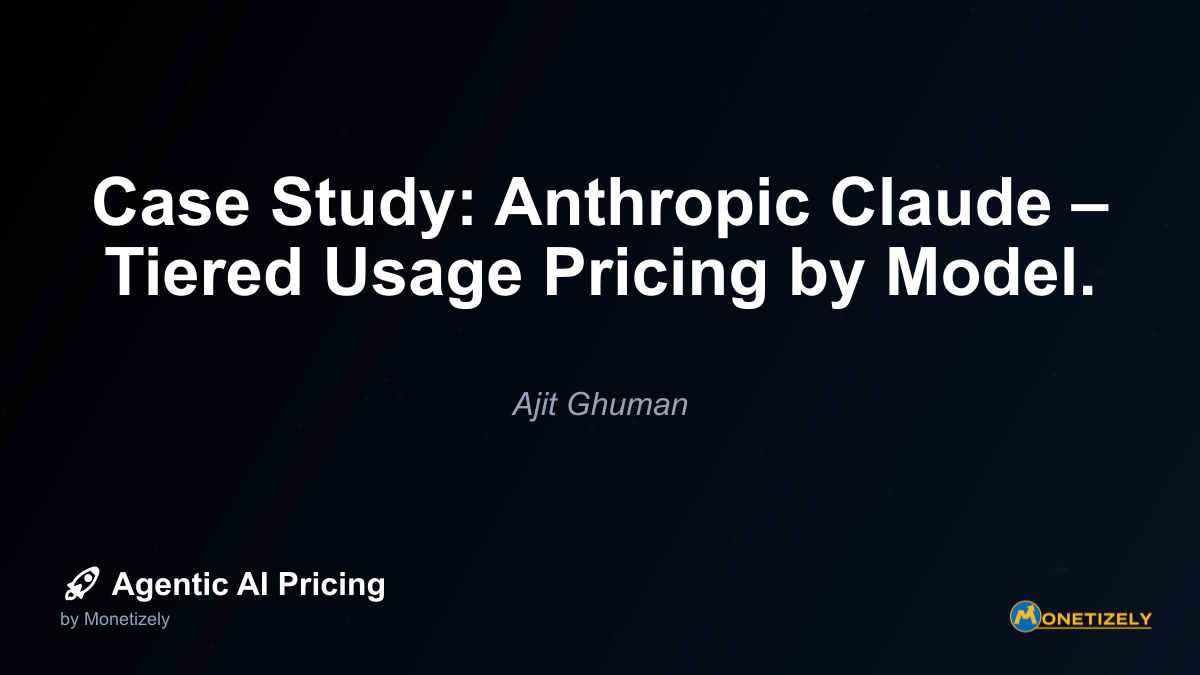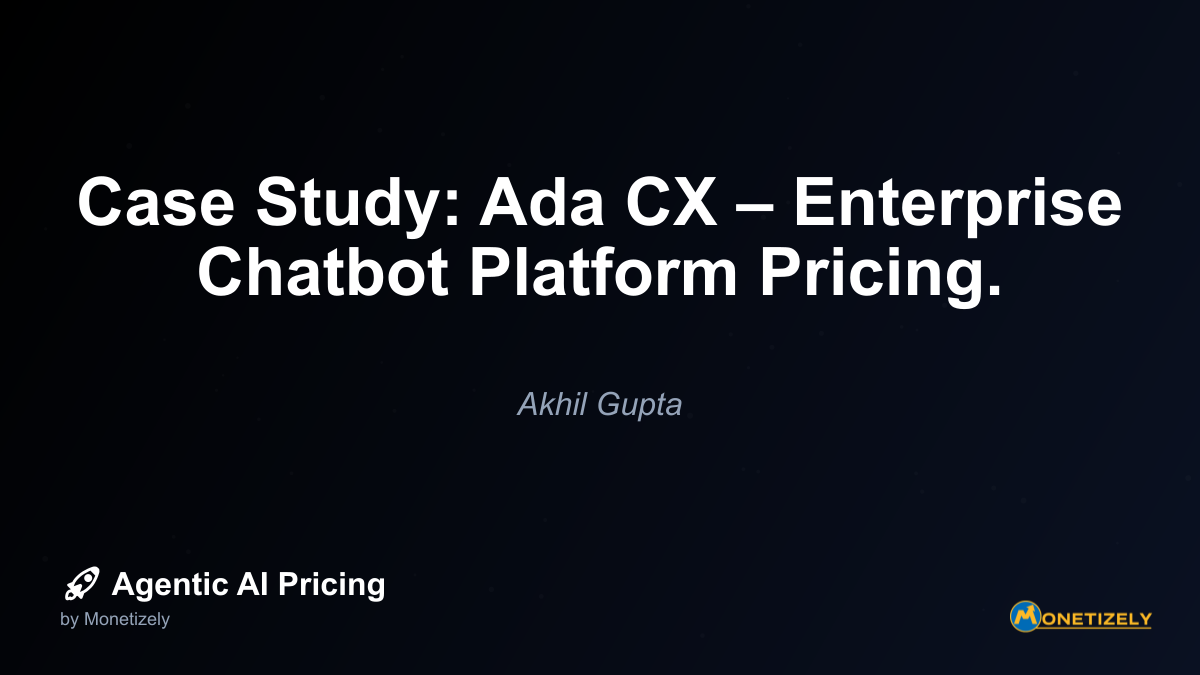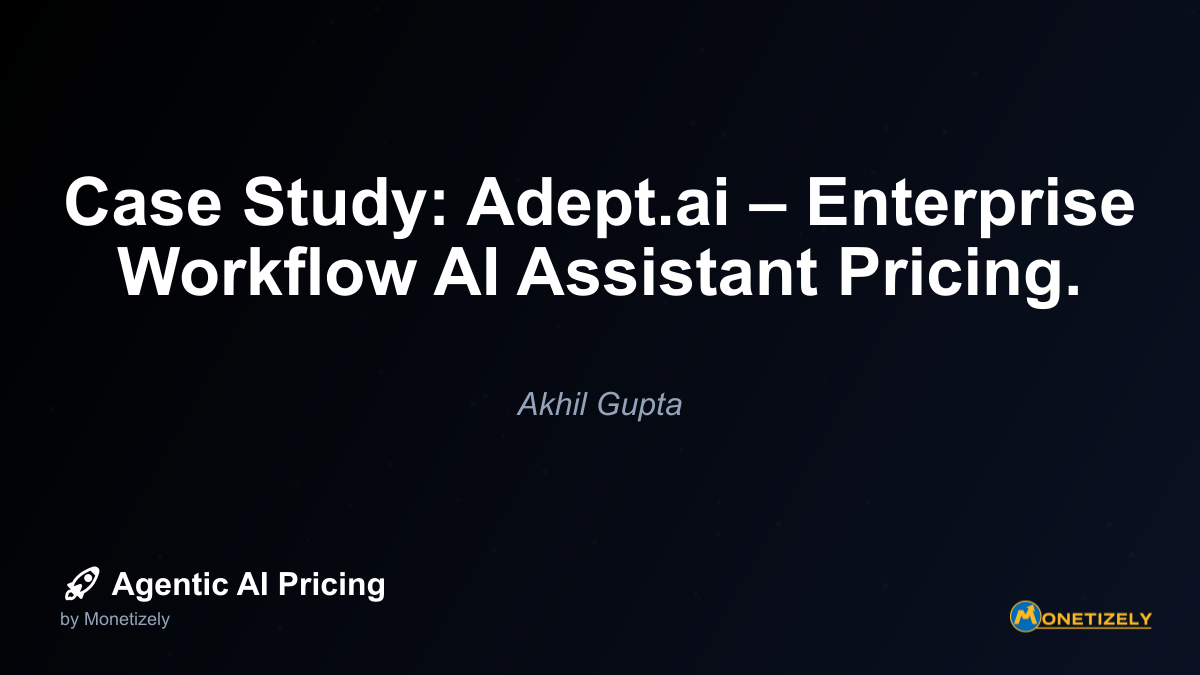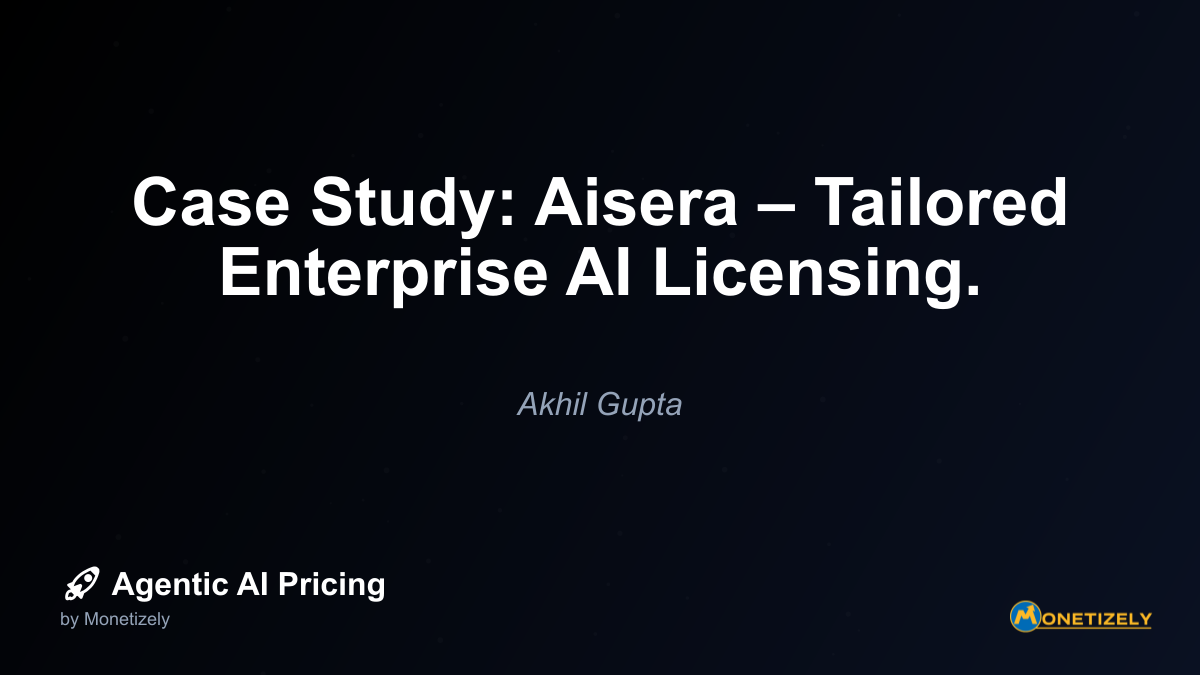· Ajit Ghuman · Case Studies · 7 min read
Case Study: Anthropic Claude – Tiered Usage Pricing by Model.
AI and SaaS Pricing Masterclass
Learn the art of strategic pricing directly from industry experts. Our comprehensive course provides frameworks and methodologies for optimizing your pricing strategy in the evolving AI landscape. Earn a professional certification that can be imported directly to your LinkedIn profile.

Practical Applications of Anthropic’s Tiered Pricing Model
Customer Self-Selection and Value Alignment
Anthropic’s tiered model approach creates natural customer segmentation. Organizations can easily identify which model best aligns with their specific needs:
- Cost-sensitive applications: Businesses with high-volume, relatively straightforward needs (like basic customer support) gravitate toward Claude Instant or Claude 3 Haiku
- Balanced performance: Companies needing reliable reasoning and more sophisticated capabilities without the highest costs choose Claude 2 or Claude 3 Sonnet
- Premium performance: Organizations requiring the most advanced capabilities for complex tasks select Claude 3 Opus
This self-selection mechanism helps customers find their optimal price-performance balance while maximizing Anthropic’s revenue by capturing appropriate value from each segment.
Optimizing for Different Use Cases
The tiered approach acknowledges that different AI applications have vastly different requirements:
- Content generation: May require less sophisticated models but high throughput
- Complex reasoning: Benefits from more advanced models with better logical capabilities
- Specialized domains: Some applications need the most capable models for handling domain-specific knowledge and nuance
By offering models optimized for different scenarios, Anthropic allows customers to select the most cost-effective solution for their specific applications rather than forcing a one-size-fits-all approach.
Enabling Experimentation and Growth
This tiered structure also creates a low-risk entry point for organizations just beginning to explore AI capabilities. Companies can:
- Start with lower-cost models to experiment and develop initial use cases
- Gather data on performance and business impact
- Gradually upgrade to more sophisticated models as they identify high-value applications
- Optimize their usage patterns based on real-world experience
This “crawl-walk-run” approach reduces barriers to adoption while creating a natural upgrade path as customers become more sophisticated in their AI implementation.
How Anthropic Differentiates Between Model Tiers
What makes Anthropic’s approach particularly instructive is how they clearly differentiate between their model tiers. The distinctions fall into several categories:
Performance Characteristics
Each model tier offers different performance profiles:
- Response speed: Lower-tier models like Claude Instant are optimized for faster response times
- Context window: Higher-tier models typically support longer context windows, allowing for more comprehensive understanding of inputs
- Reasoning quality: Premium models demonstrate more sophisticated reasoning capabilities
- Instruction following: Higher-tier models generally follow complex instructions more reliably
These performance differentiators create tangible value distinctions that justify the price differences between tiers.
Specialized Capabilities
Higher-tier models often include enhanced capabilities in specific domains:
- Code generation and understanding
- Mathematical reasoning
- Multimodal capabilities (like image understanding)
- Nuanced ethical reasoning
These specialized capabilities create clear use cases where the premium pricing of higher-tier models delivers proportional value.
Reliability and Consistency
Another important differentiator is the consistency and reliability of responses:
- Reduced hallucinations: Higher-tier models typically produce fewer factual inaccuracies
- Better edge case handling: Premium models handle unusual or complex queries more gracefully
- More consistent formatting: Higher-end models maintain requested output formats more reliably
For many enterprise applications, this increased reliability justifies the premium pricing of top-tier models, as it reduces the need for human oversight and correction.
Lessons for AI Companies Developing Pricing Models
Anthropic’s approach offers valuable insights for other companies building AI pricing strategies:
1. Create Clear Value Tiers
The most effective tiered pricing models establish distinct, easily understood value differences between tiers. Avoid creating tiers with marginal differences that confuse customers or cannibalize higher-tier offerings.
For example, a company might structure tiers around:
- Basic (foundational capabilities)
- Professional (enhanced performance and reliability)
- Enterprise (maximum capability and customization)
Multi-tier AI pricing works best when customers can easily identify which tier aligns with their needs.
2. Align Pricing with Cost Structure
Effective tiered pricing should reflect the underlying cost structure of providing different service levels. Consider:
- Computational resources required
- Development and maintenance costs
- Support and infrastructure needs
- Market positioning and competitive landscape
This alignment ensures sustainable margins across all tiers while creating appropriate price differentiation.
3. Enable Value-Based Self-Selection
Design your tiers to guide customers to the appropriate level based on the value they’ll derive, not just their budget constraints. This means:
- Clearly communicating the use cases each tier best serves
- Providing tools to help customers estimate their needs
- Offering easy upgrade paths as needs evolve
- Creating natural progression between tiers
4. Consider Hybrid Approaches
While Anthropic focuses primarily on token-based pricing differentiated by model capability, many AI companies can benefit from hybrid approaches that combine:
- Usage-based components (like token pricing)
- Subscription elements for predictable base capabilities
- Feature-based differentiation beyond raw model performance
- Volume discounts for larger customers
Token-based versus subscription pricing represents a fundamental strategic choice that should align with your customers’ usage patterns and value perception.
Implementation Considerations for Tiered AI Pricing
Companies looking to implement a tiered pricing strategy similar to Anthropic’s should consider several practical factors:
Transparency and Predictability
Customers value being able to predict their costs. Consider providing:
- Clear pricing documentation with examples
- Usage calculators or estimators
- Monitoring tools for tracking consumption
- Budget controls to prevent unexpected overages
Anthropic provides detailed documentation on token counting and pricing to help customers estimate and control their costs.
Technical Implementation Requirements
Implementing tiered pricing requires robust technical infrastructure:
- Accurate usage metering systems
- Real-time tracking and reporting
- Tier selection and switching capabilities
- Billing integration and automation
These technical elements are essential for delivering a seamless customer experience while accurately capturing revenue.
Customer Education
For many organizations, AI pricing models represent unfamiliar territory. Successful implementation requires:
- Clear documentation on how pricing works
- Guidance on selecting the appropriate tier
- Best practices for optimizing usage
- Case studies demonstrating ROI at different tiers
Anthropic invests significantly in educational resources to help customers understand their pricing model and select the appropriate tier.
Market Positioning and Competitive Considerations
Anthropic’s tiered pricing approach also reveals important strategic considerations for market positioning:
Competitive Differentiation
The tiered model allows Anthropic to compete effectively on multiple fronts:
- Against lower-cost alternatives with their entry-level models
- Against premium competitors with their high-end offerings
- Across different use cases with models optimized for various scenarios
This flexibility helps them capture market share across different segments while maintaining brand positioning.
Balancing Accessibility and Exclusivity
The tiered approach strikes a balance between:
- Making AI capabilities accessible to a broad range of customers
- Maintaining premium positioning for advanced capabilities
- Creating aspirational upgrade paths
- Preserving margins on high-value offerings
This balance is crucial for maximizing both market adoption and revenue potential.
Responding to Market Evolution
The AI landscape is rapidly evolving, and pricing strategies must adapt accordingly. Anthropic’s tiered approach provides flexibility to:
- Introduce new models as technology advances
- Adjust pricing as competitive pressures change
- Respond to shifting customer expectations
- Capture value from emerging use cases
This adaptability is essential in a market characterized by rapid innovation and changing competitive dynamics.
Future Directions in AI Model Pricing
Looking ahead, Anthropic’s current approach suggests several potential evolutions in AI pricing:
Increased Specialization
We may see further specialization of models for specific domains or use cases, each with tailored pricing:
- Industry-specific models (legal, medical, financial)
- Function-specific models (creative, analytical, procedural)
- Context-optimized models (short interactions vs. long-form collaboration)
This specialization would allow for even more precise value-based pricing.
Outcome-Based Components
Future pricing may incorporate elements tied to business outcomes:
- Performance-based pricing components
- Success fees for specific achievements
- Value-sharing models for high-impact applications
- ROI-linked pricing structures
These approaches would more directly align pricing with the value created.
Bundling and Ecosystem Integration
As AI capabilities become more integrated into broader business ecosystems, pricing may evolve to include:
- Cross-product bundles with complementary tools
- Ecosystem-based pricing for integrated workflows
- Partner network pricing advantages
- Platform-based pricing models
These approaches would reflect the increasingly interconnected nature of AI solutions.
Conclusion: Key Takeaways from Anthropic’s Tiered Pricing Approach
Anthropic’s tiered model pricing strategy offers several valuable lessons for organizations developing their own AI pricing approaches:
- Clear value differentiation between tiers creates natural customer segmentation and maximizes revenue potential
- Performance-based tiering allows customers to select the appropriate price-performance balance for their specific needs
- Token-based metering provides a transparent, usage-based approach that scales with customer value
- Multiple entry points create accessibility while preserving premium positioning for advanced capabilities
- Capability-aligned pricing reflects both cost structure and value delivery
For organizations developing agentic AI solutions, Anthropic’s approach demonstrates how thoughtfully structured tiered pricing can balance accessibility, profitability, and value alignment. By creating distinct capability tiers with corresponding price points, companies can serve diverse market segments while capturing appropriate value from each.
As the AI landscape continues to evolve, pricing strategies will need to adapt accordingly. However, the fundamental principles demonstrated by Anthropic’s approach—aligning price with value, enabling customer self-selection, and creating clear upgrade paths—will remain essential elements of successful AI pricing strategies.
Organizations that thoughtfully apply these principles to their own AI offerings will be well-positioned to create sustainable business models that balance customer value with profitable growth in this rapidly evolving market.
Co-Founder & CEO
Ajit is the author of Price To Scale, a top book on SaaS Pricing and is the Founder of Monetizely. Ajit has led and worked in pricing and product marketing at firms like Twilio, Narvar and Medallia. His work has been featured in Forbes and VentureBeat. Ajit regularly consults with software companies from Seed stage to post-IPO on pricing strategy. Ajit is also a highly-rated co-instructor for 'The Art of SaaS Pricing and Monetization' on Maven.
Pricing Strategy Audit
Let our experts analyze your current pricing strategy and identify opportunities for improvement. Our data-driven assessment will help you unlock untapped revenue potential and optimize your AI pricing approach.




